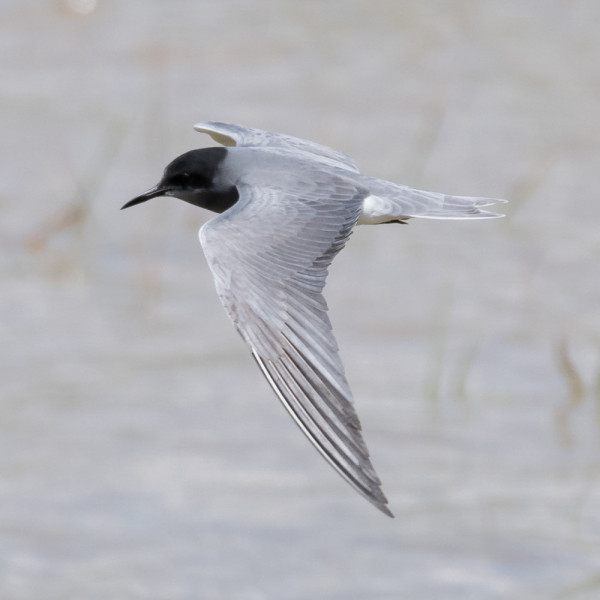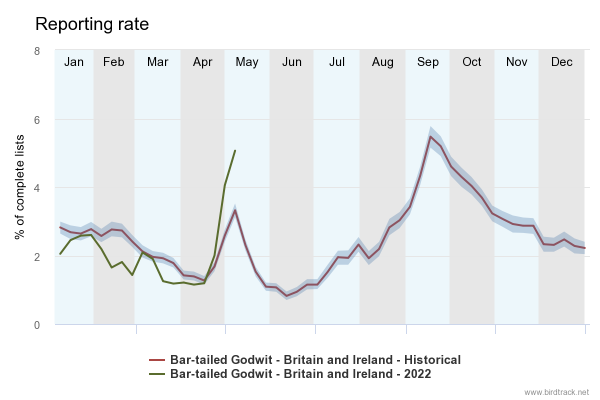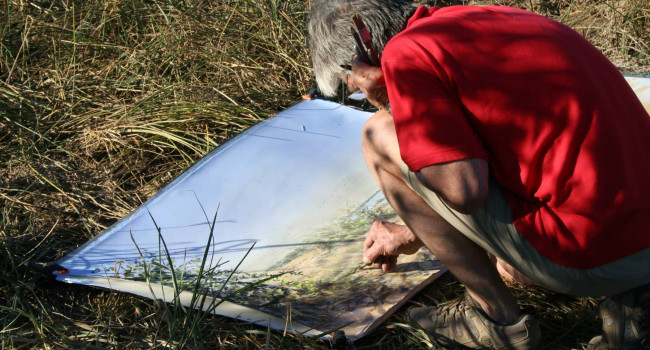
Birdtrack migration blog (13th-19th May)
Scott’s role includes the day-to-day running of BirdTrack: updating the application, assisting county recorders by checking records and corresponding with observers.
Relates to projects
The main talking point so far this spring is the absence of Swallows and House Martins across much of Britain and Ireland. The BirdTrack reporting rates for both species show that birds arrived around 7-10 days later than normal in much lower numbers than expected, given the time of year.
This delay is likely due to a combination of unseasonably cold weather across Spain, Portugal, and southwest France, and northerly winds across Britain and Ireland hampering the northward migration of these birds and keeping them in North Africa. With a change to warmer weather and a more southerly airflow, reports for both species have increased in the last week - we will have to wait to see if reports recover to their expected levels.
We also saw reports of 68,000 Swifts flying over Leucate in Southern France earlier this week, indicating their arrival in Britain and Ireland was imminent - many of us have now welcomed these birds back to the skies above our towns and cities after a pulse of birds reached their destinations.
The warmer weather of the last few days saw a steady rise in the reports of other summer migrants too, including Whitethroat, Lesser Whitethroat and Garden Warbler. The arrival of Greenland race Wheatears, earlier than expected, saw a spike in reports in late April into early May as birds passed through Britain and Ireland on a truly epic migration to their breeding grounds in Greenland.
Bar-tailed Godwit have been reported in higher numbers than expected for this time of year...let's hope this results in a good breeding season.
Waders have been arriving over the last couple of weeks with Whimbrel, Bar-tailed Godwit, and Wood Sandpiper all being reported more than usual for the time of year - let's hope this results in a good breeding season.
BirdTrack reporting rate graph for Bar-tailed Godwit, showing an unusual spike in reports in early May.
The Garden Warbler is one of the most subtle and most beautiful of our summer visitors in equal measure.

Species focus - Garden Warbler
Garden Warblers are one of our later-arriving summer migrants, with some birds not reaching their breeding grounds until mid-May. Once here, however, the Garden Warbler is one of the most subtle and most beautiful of our summer visitors in equal measure.
Its subtlety lies in its unremarkable plumage, mostly unbroken grey-brown with a grey wash around the nape, while its beauty lies in its song, which is amongst the most glorious of any British songbird and very much a sound of summer. It is a continuous flow of low and high gurgles uttered from the cover of a bush or shrub, bubbling along for several minutes at a time and easily a match for the much-lauded song of the Nightingale.
British Garden Warblers winter in West Africa just south of the Sahara and are thought to show great site fidelity, returning to the same area winter after winter. There is some debate as to the strategy Garden Warblers employ when crossing the Sahara: while some believe the birds complete the 2,000-mile crossing in one single flight (easily doable with a full loading of fat and a tailwind to help), while others think that the desert flight is broken by stops at oases. Garden Warblers are regularly observed resting and feeding at desert oases and in truth, both strategies are probably used.
It is estimated that the British breeding population is around 145,000 pairs, although in recent years it has experienced a decline of 18%. It is currently 'green listed' as of Least Concern.
Garden Warbler can be found across the UK but the population begins to thin out in the north, is largely absent in northern Scotland and almost completely absent in Ireland.

Looking ahead
The weekend looks to remain largely settled, with high pressure centred over Britain and Ireland bringing a rise in temperatures and light south to south easterlies. These conditions will likely see the arrival of some of the later migrating species such as Spotted Flycatcher, Turtle Dove, and Swift. With little or no rain forecast for the weekend, many of these species will probably head straight to their breeding grounds, without the need to seek shelter from bad weather. However, they could turn up almost anywhere, so any likely spots will be worth checking in the next few days.
Although many of our summer visiting species will already have arrived, those populations that breed further north will still be migrating with birds heading for Scandinavia. The calmer conditions could see more Cuckoos, Wood Warblers, Reed Warblers, Pied Flycatchers, and Tree Pipits passing through Britain and Ireland as they head north, with the odd scarcity mixed in - Bluethroat, Subalpine Warbler, Iberian Chiffchaff, and Thrush Nightingales are all possible in the coming days.
The start of next week sees the wind direction change to a more easterly flow, and brings some rain for the far north which will spread east and south as we move into Tuesday. The easterly winds could produce a flush of Black Terns and Little Gulls, with birds heading to areas of water where they can rest and feed - look out for them at inland water bodies during rain showers. These same weather conditions at this time of year could also yield rarer species like Terek Sandpiper, Great Reed Warbler, Red-footed Falcon or Broad-billed Sandpiper.
We'd love to hear from you.
Seen your first Swift?
Looking for a Bluethroat?
Leave your comments and
questions for our migration
experts below.
to help us monitor the migration period over the coming weeks.
Find out more








Share this page